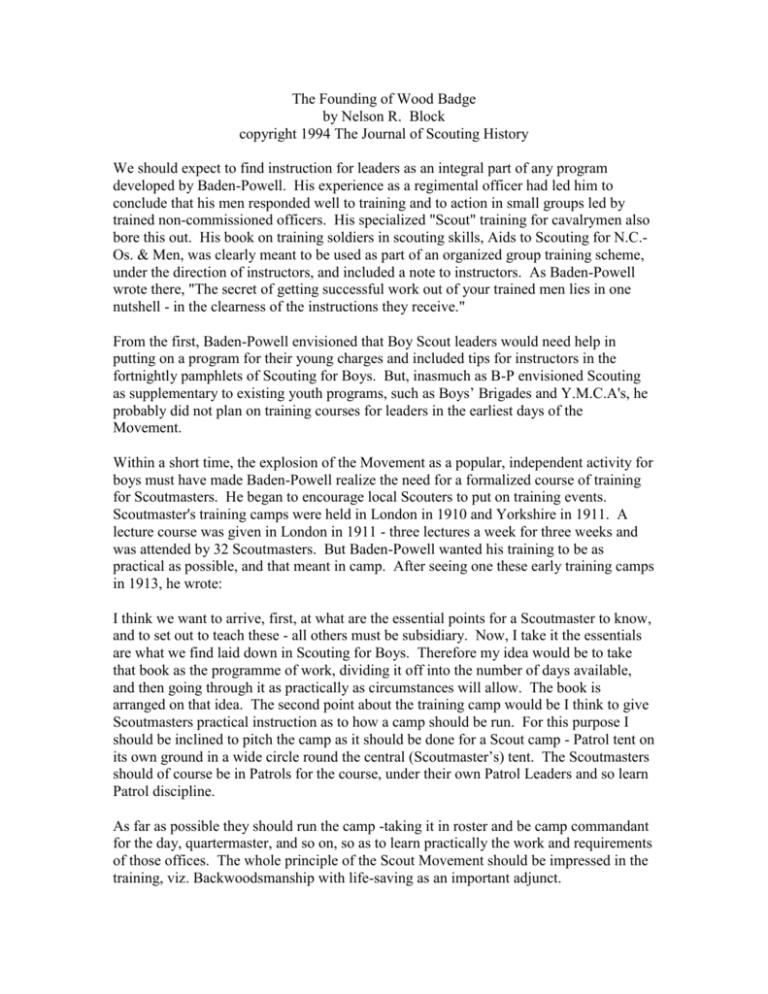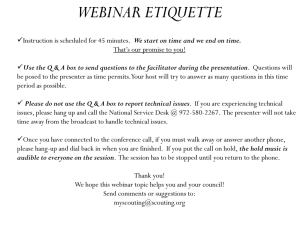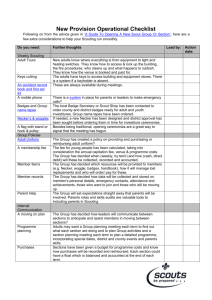
The Founding of Wood Badge
by Nelson R. Block
copyright 1994 The Journal of Scouting History
We should expect to find instruction for leaders as an integral part of any program
developed by Baden-Powell. His experience as a regimental officer had led him to
conclude that his men responded well to training and to action in small groups led by
trained non-commissioned officers. His specialized "Scout" training for cavalrymen also
bore this out. His book on training soldiers in scouting skills, Aids to Scouting for N.C.Os. & Men, was clearly meant to be used as part of an organized group training scheme,
under the direction of instructors, and included a note to instructors. As Baden-Powell
wrote there, "The secret of getting successful work out of your trained men lies in one
nutshell - in the clearness of the instructions they receive."
From the first, Baden-Powell envisioned that Boy Scout leaders would need help in
putting on a program for their young charges and included tips for instructors in the
fortnightly pamphlets of Scouting for Boys. But, inasmuch as B-P envisioned Scouting
as supplementary to existing youth programs, such as Boys’ Brigades and Y.M.C.A's, he
probably did not plan on training courses for leaders in the earliest days of the
Movement.
Within a short time, the explosion of the Movement as a popular, independent activity for
boys must have made Baden-Powell realize the need for a formalized course of training
for Scoutmasters. He began to encourage local Scouters to put on training events.
Scoutmaster's training camps were held in London in 1910 and Yorkshire in 1911. A
lecture course was given in London in 1911 - three lectures a week for three weeks and
was attended by 32 Scoutmasters. But Baden-Powell wanted his training to be as
practical as possible, and that meant in camp. After seeing one these early training camps
in 1913, he wrote:
I think we want to arrive, first, at what are the essential points for a Scoutmaster to know,
and to set out to teach these - all others must be subsidiary. Now, I take it the essentials
are what we find laid down in Scouting for Boys. Therefore my idea would be to take
that book as the programme of work, dividing it off into the number of days available,
and then going through it as practically as circumstances will allow. The book is
arranged on that idea. The second point about the training camp would be I think to give
Scoutmasters practical instruction as to how a camp should be run. For this purpose I
should be inclined to pitch the camp as it should be done for a Scout camp - Patrol tent on
its own ground in a wide circle round the central (Scoutmaster’s) tent. The Scoutmasters
should of course be in Patrols for the course, under their own Patrol Leaders and so learn
Patrol discipline.
As far as possible they should run the camp -taking it in roster and be camp commandant
for the day, quartermaster, and so on, so as to learn practically the work and requirements
of those offices. The whole principle of the Scout Movement should be impressed in the
training, viz. Backwoodsmanship with life-saving as an important adjunct.
Later in 1913 he shaped the course into a formal syllabus, providing for patrols of five
Scoutmasters each, each patrol camping in its own tent. Each Scoutmaster would take a
turn as patrol loader, and each patrol would supply the course Scoutmaster for one day.
By early 1914 Baden-Powell's outline had developed into a correspondence course called
"Scouting for Scoutmasters." The official Scout publication, The Headquarters Gazette,
featured a different theme each month, with questions for the Scoutmasters to answer, the
results being examined at Headquarters. The topics dealt with in the course were:
1. Character training;
2. Self-improvement for making a career;
3. Physical health and development;
4. Service for others as a basis of religion;
5. Boy training methods and national importance; and
6. Citizenhood.
The correspondence course ended with the commencement of World War I, like so many
other features of the Movement not absolutely essential to the task then facing Britain.
But the War also served as an incubation period for greater strides in training
Scoutmasters. In 1919 - with the War over end the Scouts able to focus their attention on
internal matters again Baden-Powell used his training course notes as the outline for his
book, Aids to Scoutmastership. Moreover, it was time to perfect the Scoutmaster's
training course in a camp setting.
At the same time, Baden-Powell had met success in his efforts to find a suitable camping
spot near London to serve urban youth as a campsite and Scoutmasters as a training
ground. After securing the financial support of W. de Bois Maclaren, District
Commissioner for Roseneath, Baden-Powell charged P.B. Nevill to find a suitable camp.
Nevill describes his experience thus:
The entries in my diary show that Maclaren dined with me at Roland House - on the 20th
November 1918. This was at the request of B.P., who sent him to me as he wanted to
give a camping ground for the boys of East London. He said 'you find what you want
and I will buy it.' I told him that what I wanted was a site adjoining Epping or Hainault
Forests and I spent every available week-end on my motor bike touring the area, trying to
find something. The small committee that had been set up viewed one or two sites
suggested by agents. Gilwell was first mentioned to me by a young Assistant
Scoutmaster in Bethnal Green, named Gayfer who said he had come across the estate
whilst exploring for bird life. I went to Gilwell on Saturday, 8th March, 1919. I did not
know the extent of the estate at that time but I found the old notice board advertising its
sale on the ground behind a hedge from this I managed to get the agent's name.
Negotiations were begun to purchase the estate containing 55 acres of land and a rather
dilapidated Georgian country house. By Easter 1919, the purchase process was far
enough along to secure permission for camping at the property, and on the Thursday
before Easter a small group of Rovers from East London became the first Scout campers
at Gillwell (note the spelling, which was in common use until Baden-Powell was created
a baron and returned to the spelling of Gilwell as used in old documents related to the
Estate, with three "l's"). Arriving in the rain, they spent their first night on the cement
floor of the Pigsty, but pitched camp the next morning on the other side of the Orchard,
near the Session Circle.
The purchase cost was £7,000, donated by Maclaren, who gave an additional £3,000 for
improvements to the house. Opening ceremonies were held on July 26, 1919, including a
rally of 700 Scouts. Mrs. Maclaren cut the ribbons and Baden-Powell presented
Maclaren with the Silver Wolf.
With the camping ground in place, it was now time to hold the Scoutmaster’s training
course. On July 24, Imperial Headquarters had sent out an announcement of the first
course:
FIRST SCOUTMASTERS TRAINING COURSE AT GILWELL PARK
1. The Course will commence on Monday 8th September will last till Friday 19th.
2. Members should book to Chingford and must leave Liverpool Street by the 5.5 P.M.
train. A brake will meet this train at Chingford Station.
3. The Course will be carried out in Camp. Tents, ground sheets, and cooking utensils
will be provided there.
4. A fee of £5- will be charged for the Course in order to cover incidental expenses. All
catering will be arranged by, and the cooking done in, the patrols into which members of
the Course will be divided on arrival; these expenses will be shared equally by the
members of the patrols.
5. The Course of instruction will be based on SCOUTING FOR BOYS, and the Chief
Scout's book "AIDS TO SCOUTMASTERSHIP," and will include lectures and practical
work in campcraft, nature study, general scouting, organization and methods of running
patrols and troops.
6. Those attending the Course should wear correct Scout uniform; shorts and not
breeches should be worn except for medical reasons.
7. The following article: must be brought:
A. SCOUTING FOR BOYS, which should have been read beforehand.
B. Notebook and sketchbook.
C. Blankets, clothing and personal equipment as given in SCOUTING FOR BOYS,
pages 109-110.
8. Applications to attend this Course should be sent to Imperial Headquarters by
Saturday 9th August. Baden-Powell added a note to some of the announcements, "Your
name has been included in the first course, B-P." Sometime in late summer a training
course attended by 25 Scouters was conducted by the East London Association, under its
own leadership for members of that group.
The first Wood Badge course was held, as scheduled, from September 8th to 19th.
Although Baden-Powell had outlined the course syllabus, he did not lead the course, but
left that to the newly appointed Camp Chief, Francis "Skipper" Gidney. Gidney was a
young man who had served as a captain during the War and had immense energy and,
most important from Baden-Powell's view, tremendous spirit. His Assistant Scoutmaster
was Capt. F.S. Morgan, District Commissioner for Swansea. Baden-Powell visited the
camp Friday night and Saturday, together with Major A.G. Wade, Joint Managing
Secretary of the Association and the man who was to organize the first World Jamboree
the next year. The Founder gave a talk to the Scoutmasters, and led a tracking
demonstration on Sunday morning filled with personal anecdotes. Other distinguished
Scouters who served as instructors were Deputy Chief Commissioner Col. Ulick G.C. de
Burgh, Deputy Chief Scout Percy W. Everett (who had been a part of Scouting since the
Brownsea camp), Hubert S. Martin (later Director of the Scouts International Bureau),
R.S. Wood (who ran Gilwell for a time when Gidney was sick), P.B. Nevill, Rev. R.
Hyde, and Imperial Headquarters Assistant Secretary D.F. Morgan.
The participants enjoyed good weather, except for one heavy thunderstorm which, as
Gidney wrote, "had its instructive value also!" These men had come from different parts
of England and Wales, were of various ages and different professions. The roster of the
first Wood Badge course follows:
Capt. F. Gidney, Camp Chief, Gilwell Park.
Capt. F.S. Morgan, Glamorgan.
Maj. the Rev. C.P. Hines, Gt. Yarmouth.
C. Robson, Colchester.
L.J. Berlin, Manchester.
Rev. W.A. Butler, Sussex.
M.F. Bunt, Sussex.
J.R. Davies, Cheshire.
J.F. Wilkinson, Cheshire.
A.W. Todd, Cheshire.
E. Fay, Yorkshire
J. Kent, Essex.
Ronald Firth, Suffolk.
R. Hammond , London.
C.C. Eiffe, London.
Rev. H.W. Nevill, London.
S. Phillips, London.
D. Earle, London.
Rev. W.E. Baker, London.
R. Lang, Cambridge.
The men were organized into three patrols, each one taking his turn as patrol leader,
"second," "bottom" and the other turns in the order of patrol jobs, including cooking.
Although in some camp schemes a late lunch was the big meal of the day, Gidney
scheduled the main meal in the evening, to insure no one missed any of the Scoutcraft
instruction.
Troop Organization. –
Patrols formed - Practiced calls, etc. - Drill with staves - Troop formation - Patrol
formation on the march (by day and night) -- Scouts' pace --Typical investiture "Erogonyama" chorus -- -How to "break" the flag -- Camp hygiene -- physical exercises
(the six from "Scouting for Boys").
Campcraft –
(a) Campsites. Selection -- Sanitation -- Fires -- Pitching and Striking camps
(b) Camp expedients. – Illuminations – Kitchen Implements -- Beds and sleeping
appliances -- Personal comforts -- Camp tidiness – Tent expedients -Miscellaneous.
Pioneering. –
(a) Axmanship - Felling – Use of crosscut saw, wedges, grindstone -- Use care of
knife.
(b) Construction. — Rope and trestle bridge building across water -- Simple and
swinging derrick -- Use of tackle.
Woodcraft. –
(a) Birds and animals. -- Those found in the locality, their habits and uses -- Use of
Nature notebook.
(b) Trees, - How to identify them near to and far off during four seasons -- How to
get the Scout keen on the subject.
Signcraft. –
(a) Signaling – Hand – Whistle -- Smoke - How to teach Semaphore and Morse –
Pitfalls to avoid.
(b) Nature trails.
(c) Sand tracking (carried out by the Chief Scout).
Games. –
(a) Scouting. – Description and actual playing of each type.
(b) Camp. – Played for one hour each day.
Fieldwork. –
(a) Measurements.—Personal Distances -- Heights – Areas – River Widths.
(b) Mapping. – How to read – making sketch maps. Prismatic compass – Panoramic
drawing – Reports.
Study Circle Work. –
(a)
(b)
(c)
(d)
(e)
"Aids to Scoutmastership,"
Headquarters "Book of Rules."
"Rules for Rover Scouts and Wolf Cubs,"
"Our Aims, Methods and Needs."
"Sunday and the Scout." Pathfinding. - Patrols sent out separately with sealed
orders to from various points across Epping Forest, for eight-hour stretch - Leaf
collecting - Report of journey - Sketch map of trek - Panoramic drawing from
given point.
The first Wood Badge feast was not prepared by the course participants, but was held in
London at the Scout's Club, where Everett treated them to lunch. They then enjoyed a
tour of Imperial Headquarters, and a final talk the Chief Scout, who encouraged each
participant to start a course in his neighborhood using Aids to Scoutmastership as a
guide.
The course having been completed, it remained to find a suitable award for the
participants. Baden-Powell came upon the necklace of hand-carved beads he had taken
from Zulu Chief Dinizulu during the Ashanti campaign in 1888. One bead was awarded,
to be worn on a leather thong pinned to the shirt. Thus began the tradition of advanced
leadership training for Scouters - another mighty oak grown from the acorn planted at
Gilwell.
The story of Baden-Powell's early Scoutmaster training efforts and much of the
information on the first Wood Badge course can be found in E.E. "Josh" Reynolds the
"The Scout Movement" (Oxford University Press, 1950), Reynolds was an early Scouter
and came to Gilwell as a Deputy Camp Chief in 1920.
Other sources include two books published by The Scout Association, The Gilwell Book
(10th edition, 1965) Gilwell Story (1969), the latter written by The Scout Association's
veteran General Editor, Rex Hazlewood, M.B.E., a Gilwell Deputy Camp Chief for more
than 30 years.
The information on the staff, weather, and program for the first course is from Gidney's
report, "Scoutmasters' Training Course" in the Headquarters Gazette, October 1919, page
189. This material, together with the announcement of the first course, the roster of
participants in the first course and facts relating to the Dinizulu beads, comes from the
archives of The Scout Association, and was graciously provided by the Archivist, Paul
Moynihan, and his predecessor, Graham A. Coombe.
Compliments of The Journal of Scouting History
1001 Fannin, Suite 3700, Houston, Texas 77002.
Copyright © Nelson R. Block, 1998
Copyright © 1996-2000, Mike Barnard. All rights reserved. This material is for personal
use only. Republication and redissemination, including posting to news groups, is
expressly prohibited without prior written consent. Last Modified: 15:07 on December
27, 2001. Views expressed on these pages may not necessarily represent those of the
Boy Scouts of America. While every effort has been made to ensure the accuracy of this
information, nothing here should be interpreted as official policy.







